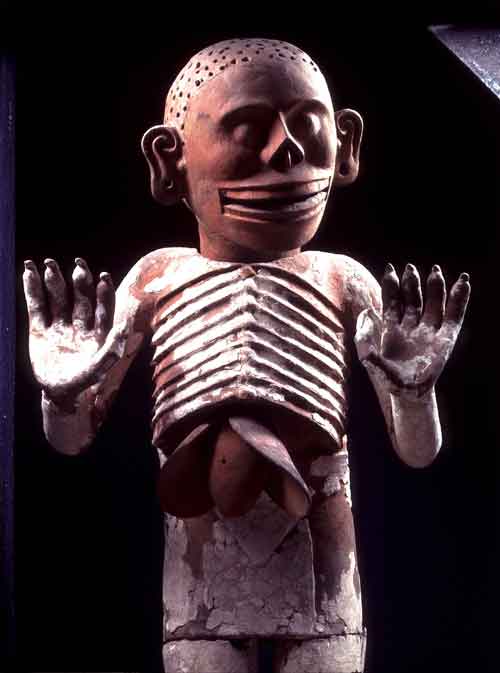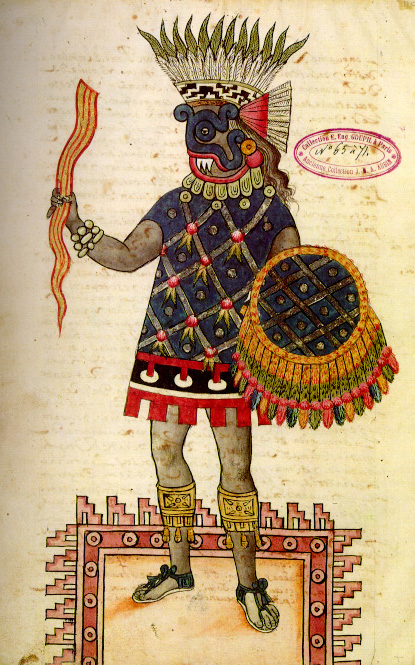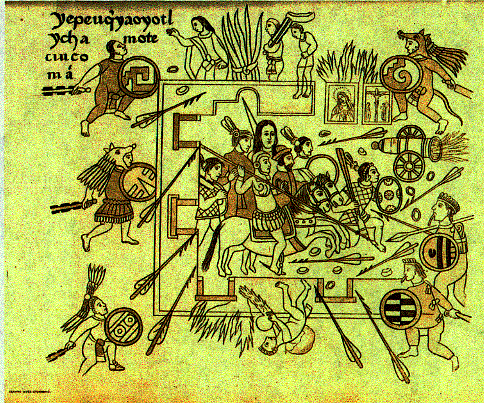
HIST 109: Latin American History
The Conquest and Colonization of Spanish America
Fall 2007
Mr. Volk
Monday, Wednesday, Friday 9:00-9:50 AM (King 337)
Office: Rice 309
Office Phone: 58522
Email: Steven.Volk@oberlin.edu
Office Hours: Mon 11-noon; Wed 10-11;
Thurs 1:30-2:30
ACCESSING THE COURSE: Course materials can be found on the Blackboard system. Course materials can be found on the Blackboard system. This electronic bulletin board will post all the outlines for the course lectures, PowerPoint slides, the syllabus, exams and paper assignments, and other materials useful for the course. Anyone registered for the course will be automatically registered for Blackboard as well; you access it via your regular username and password. Please let me know if you are having any problems accessing Blackboard or any of the other electronic portals you need.

Mictlantecuhtli, c.1480, Aztec. Fired clay, stucco and paint, 176 x 80 x 50 cm. Museo del Templo Mayor, Mexico City, CONACULTA-INAH. Photo Michel Zabe
Purpose and Goals of Course:
This semester's course will concentrate on the pre-Columbian background of the Americas, the conquest period, and the three centuries of Spanish and (to a much more limited extent) Portuguese colonial rule. The lectures will follow both chronological and topical paths. The two key geographic areas of examination will be central Mexico, the location of a number of highly structured pre-Columbian societies and later the seat of Spanish power in northern Latin America (the Viceroyalty of New Spain), and the central Andes, home of the Incas (among others), and locus of Spanish power in southern Latin America (the Viceroyalty of Peru). The course has been designed with a number of goals in mind:
To introduce students to some of the forces, events, and conflicts which have helped shape current-day Spanish America (and, to a lesser extent, Brazil and the Caribbean), including:
To understand and use a variety of sources
(or evaluate the lack of sources) which make up the contemporary "archive"
of historians, including:
To find, understand, and critique historical argument:
To understand, and appreciate, ambiguity
in historical argument and presentation:
To appreciate that while the "past is a foreign country," it is intimately connected to the present through the work of the historian. Your task is to understand that the past is not the same as the present, but that the work of historians means that the questions we now ask of the past will be different than those asked by previous generations, for a variety of reasons.
Course Organization:
In general (although not always: check your syllabus!), Mondays and Wednesdays of each week will be devoted to lectures. On Fridays we will usually divide into smaller discussion groups each of which will meet for one hour. Even though Fridays often will be dedicated to small-group discussions, students are encouraged to participate actively during other class sessions as well.
You can access the course texts in a variety of ways: (1) Required texts are on sale at the bookstore (or can be purchased on-line); (2) you can find all the texts plus the xeroxed articles on reserve in the library; the texts can also be obtained through OHIO LINK; (3) you can access all the Xeroxed articles on Electronic Reserve. Finally, some articles are available in full-text editions via JSTOR, an impressive electronic collection of major academic journals. To access materials via Electronic Reserve (ERes), once you access the ERes home page (via the URL above), go to History 109 and click on it. You will be given the password to access ERes in class. To access JSTOR and on-line articles, click on the hot link for the article. Please let me know if you are having any difficulties accessing any materials.
SOURCES ON LATIN AMERICA:
I have compiled a great number of internet sources on Latin America at Sources and Resources on Latin America. This resource includes a variety of materials from the history of Latin America to organizations and publications of interest to activists working on Latin American issues.ASSIGNMENTS & GRADING POLICY
Besides the weekly readings, which you are expected to complete in a timely fashion, there are four written assignments in the course: one short (3-5 page) paper; one take-home midterm examination, one collaborative Wiki project, and a final paper. I will take into account excessive absence from the class or discussion sections when determining your final grade. Assignments are to be turned in on (or before) the due date noted in the syllabus. Late papers turned in without prior permission - you must request an extension before the due date of the paper - will be reduced by one grade-step for each day that the assignment is late. For example, a paper due on Monday, September 24 which is turned in on September 25 will get a "B-" instead of the "B" that it merited; if it is turned in on September 26, it will get a "C+", etc. Your first three assignments must be turned in no later than December 16, or they won't be counted (i.e., I will not allow an "Incomplete" in the course to allow you to finish those assignments). Your final papers are due no later than 4:00 PM on December 20. No papers turned in after that time will be accepted unless you apply to take an "Incomplete" in the course; in which case you must talk to me and fill out the appropriate paper work. YOU CANNOT PASS THE COURSE UNLESS YOU COMPLETE ALL THE ASSIGNMENTS.
Your final grade will be determined as follows:
First Paper: 20%
Mid-term Exam: 30%
Wiki Project: 20%
Final Paper: 30%
THE HONOR CODE
Oberlin College is on the Honor Code. Information on what this means (e.g. cheating, plagiarism, fabrication) and your responsibilities as students can be found at the Honor Code site. You must sign the honor code on all written assignments.
FINAL NOTE: If you are having problems with the readings, the lectures, or want to discuss further any aspect of the course (from content to class dynamics), I strongly encourage you to see me during office hours or to make an appointment. Please don’t wait until late in the semester to express these concerns.

BOOKS RECOMMENDED FOR PURCHASE:
Mark A. Burkholder & Lyman Johnson, Colonial Latin America, 6th ed. (NewYork: Oxford), 2007.
Stuart B. Schwartz, Victors and Vanquished:
Spanish and Nahua Views of the Conquest of Mexico (Boston: Bedford/St. Martins),
2000.
Ward Stavig, The World of Túpac Amaru: Conflict, Community, and Identity in Colonial Peru (Lincoln: University of Nebraska Press), 1999.
Irene Silverblatt, Modern Inquisitions. Peru and the Colonial Origins of the Civilized World (Durham: Duke), 2004.
The Water God, Tlaloc in Codex Ixtlilxochitl;
Mexican,16th century; European paper, polychrome and metal leaf; 12 1/4 x 8
1/4 in.
Bibliothèque Nationale, Paris
SYLLABUS
Sept. 5: Introduction [NOTE: I will be out of town at a conference
on Friday, Sept. 7 - no class]
Seymour Phillips, "The Outer World of the European Middle Ages," in Stuart B. Schwartz, ed., Implicit Understandings (NY and Cambridge: Cambridge Univ. Press, 1994), pp. 23-63. [ERes and regular reserve].
Mark A. Burkholder & Lyman L. Johnson, Colonial Latin America, 5th ed. (New York: Oxford University Press, 2004) [Hereafter CLA]: pp. 23-33.
Sept.10, 12, 14: Mesoamerican Background [NOTE: You may be excused from class on the 14th if you are observing the 2nd day of Rosh Hashana]
CLA: pp. 1-18.
Inga Clendinnen, "The Costs of Courage in Aztec Society," Past & Present, no. 107 (May 1985): 44-89. [Available on JSTOR as a download and at Course Documents].
J. Eric Thompson, "The Meaning of Maize for the Maya," in Gilbert M. Joseph and Timothy J. Henderson, eds., The Mexico Reader: History, Culture, Politics (Durham: Duke University Press, 2002), pp. 86-91. [ERes and regular reserve]
Sept. 17, 19, 21: Andean Background
CLA: pp. 18-23.
Gordon Brotherston, "Tahuantinsuyu," Book of the Fourth World. Reading the Native Americans Through Their Literature (New York: Cambridge University Press, 1992), pp. 193-211. [ERes and regular reserve]
Ward Stavig, The World of Túpac Amaru: Conflict, Community, and Identity in Colonial Peru (Lincoln, NB: University of Nebraska Press, 1999), Introduction and Ch. 1 (xiii-xxxiv, 1-23).
Sabine MacCormack, Religion in the Andes: Vision and Imagination in Early Colonial Peru (Princeton: Princeton University Press, 1991), pp. 98-137. [ERes and regular reserve]
Stirrup-spout jar, Mochica style (northern Peru). Height 27 cm. Circa 600-400 B.C.E.
Museo Arquelogico, Lima, Peru.
First paper due on September 24: Critical review of Clendinnen, "The Costs of Courage in Aztec Society"
Sept. 24, 26, 28: The Early Encounter: European Intellectual Orientation to the "New World"
CLA: pp. 40-48.
Patricia Seed, "'A New Sky and New Stars:' Arabic and Hebrew Science, Portuguese Seamanship and the Discovery of America," in Ceremonies of Possession in Europe's Conquest of the New World, 1492-1640 (New York: Cambridge University Press, 1995), pp. 100-148. [ERes and regular reserve].
Christopher Columbus Log (1492): Excerpts in English. Focus on period from October 11 to end.
Antonio Montesinos, "Advent Sermon" (excerpts in Blackboard, Course Documents).
"The relación of Fray Ramón Pane," (c. 1494-1496 in Hispaniola), 14 pgs.
Laws of Burgos (1512-1513).
Palacios Rubios, "The Requirement," or Requerimiento

Spanish fight their way out of
headquarters in Tenochtitlán, from El Lienza de Tlaxcala (Tlaxcalan)
(Notice "La Malinche" and Cortes' Tlaxcalan allies in the center)
Oct. 1, 3, 5: Encounter II: The Conquest of the Native Empires (Mexico, Peru)
CLA: Chapter 2 (pp. 44-80).
Stuart B. Schwartz, Victors and Vanquished: Spanish and Nahua Views of the Conquest of
Mexico (Boston: Bedford/St. Martins, 2000), pp. 29-213.
Oct. 8, 10, 12: Setting up for the "Long Haul"
CLA: Chapter 3 (pp. 83-108).
Inga Clendinnen, "Disciplining the Indians: Franciscan Ideology and Missionary Violence in Sixteenth-Century Yucatán," Past and Present, no. 94 (February 1982): 27-48. [JSTOR and Course Documents]
Abel A. Alves, "Of Peanuts and Bread: Images of the Raw and the Refined in the Sixteenth-Century Conquest of New Spain," in Francisco Javier Cevallos-Candau, et. al., eds., Coded Encounters: Writing, Gender, and Ethnicity in Colonial Latin America (Amherst: University of Massachusetts Press, 1994), pp. 62-72. [ERes and regular reserve]
Suzanne Austin Alchon, "New World Epidemics and European Colonialism," in A Pest in the Land: New World Epidemics in a Global Perspective (Albuquerque: University of New Mexico Press, 2003), pp. 109-145. Skim the "Appendix: The Demographic Debate," 147-177. [ERes and regular reserve]
Oct. 15, 17, 19: The Imposition of Colonialism
Irene Silverblatt, Modern Inquisitions. Peru and the Colonial Origins of the Civilized World (Durham: Duke, 2004), pp. 3-139.
"Letter from Lope de Aguirre, rebel, to King Philip of Spain, 1561"
Midterm due on October 19
Oct. 22-26: FALL BREAK
Oct. 29, 31, November 2: Labor and the Colonial System
CLA: Chapter 4 & 5 (pp. 111-179).
Ward Stavig, The World of Túpac Amaru: Conflict, Community, and Identity in Colonial Peru (Lincoln: University of Nebraska Press, 1999), Introduction and Chs. 4-6 (84-161).
Enrique Florescano, "The Colonial Latifundio," in Mexico Reader, pp. 131-140. [ERes and regular reserve]
Nov. 5, 7, 9: The Church and the Ideological Systems of the Spanish System
Silverblatt, Modern Inquisitions, pp. 143-185.
Sabine MacCormack, "The Great Divide: Andean Religion in Theory and Practice, 1621-1653," in Religion in the Andes: Vision and Imagination in Early Colonial Peru (Princeton: Princeton University Press, 1991), pp. 383-433. [ERes and regular reserve]
Iglesia de Santo Domingo, Cuzco, Peru -- constructed on the top of the remains of the Inca Temple of the Sun (Coricancha): Library of Congress, Prints & Photographs Division)
Nov. 12, 14, 16, 19, 21: Social Basis of Organization: Gender, Race, Caste, Class, Language
CLA: Chapters 6 & 7 (pp. 182-233).
Silverblatt, Modern Inquisitions, pp. 189-266.
Stavig, The World of Túpac Amaru, Ch. 7 (pp. 162-206).
Asunción Lavrin, "Lo Feminino: Women in Colonial Historical Sources," in Coded Encounters, pp. 153-176. [ERes and regular reserve].
Boyer and Spurling, eds., Colonial Lives, Chapter 6: "Affairs of the Courtroom: Fernando de Medina Confesses to Killing His Wife (Charcas, 1595)," pp. 54-76. [ERes and regular reserve]
Boyer and Spurling, eds., Colonial Lives, Chapter 10: "Wife of My Soul and Heart, and all My Solace: Annulment Suit Between Diego Andrés de Arenas and Ysabel Allay Suyo (Huanuco, Peru, 1618)," pp. 130-140. [ERes and regular reserve]
Boyer and Spurling, eds., Colonial Lives, Chapter 19: "Permission to Marry: 18th Century Matrimonial Files (Montevideo 1786)," pp. 236-248. [ERes and regular reserve]
Sor Juana Inés de la Cruz, "Beauteous Intelligence," from The Sceptre of Saint Joseph
Sor Juana Inés de la Cruz, "On Men's Hypocrisy," in Mexico Reader, 156-159. [ERes and regular reserve]
"Casta" Painting - Mexico, 18th Century ("A Spaniard and Indian Create a Mestizo")
Third assignment due on Nov. 26: Wiki Project
Nov. 26, 28, 30, Dec. 3, 5, 7: Late Colonial Changes: Bourbon Reorganization
and the Process of Late Colonial Rebellion
CLA: Chapter 9 (pp. 280-337).
Stavig, The World of Túpac Amaru, Chs. 8-9 (pp. 207-262).
Documents from Don José Gabriel Túpac Amaru (23 December 1780) and the Execution of Túpac Amaru II, 1781 by José Antonio de Areche.
Dec. 10, 12: The Coming of Independence
CLA: Chapter 10 (338-390).
Reading period, Dec. 14-16
Final paper due on Thursday, December 20,
by 4:00 PM at the latest.